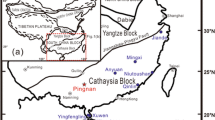Abstract.
The continental flood basalts of the East Greenland volcanic rifted margin were extruded during continental breakup above the ancestral Iceland mantle plume at 55 Ma. Three distinct magma types, the low-Ti, high-Ti and very high-Ti series (LTS, HTS and VHTS respectively), are found intercalated in the ~6-km-thick Plateau Lava sequence. Incompatible trace elements indicate that the LTS are derived from a more depleted mantle source compared to HTS and VHTS. The LTS is characterised by increasing Cu (105 to 248 ppm) and Pd (7 to 24 ppb), constant Cu/Pd ratio (~10,000), and decreasing Ir (1.1 to <0.05 ppb) and Ru (1.8 to <0.3 ppb) concentrations during magmatic differentiation (16 to 7 wt% MgO). The constant Cu/Pd ratio reflects silicate- and chromite-dominated fractionation without concurrent segregation of sulphide. S-undersaturated differentiation is also indicated in the HTS, which also displays increasing Pd (6–16 ppb) and decreasing Ir concentrations (1 to <0.05 ppb) during differentiation, and the Cu/Pd ratios for the entire series average 21,000. However, some HTS samples have elevated Cu/Pd ratios (up to 33,000). Cu/Pd ratios in the HTS do not correlate with MgO, and this is interpreted to reflect varying Cu/Pd ratios of HTS parental magmas rather than S-saturated differentiation. During S-undersaturated differentiation of the LTS and HTS, Pt/Pd ratios decrease from 1.3 to 0.11 and 1.1 to 0.2 respectively, which indicates that Pd is much more incompatible than Pt during S-undersaturated differentiation. The VHTS consists exclusively of highly evolved samples with low MgO (6.6–6.1 wt%) and Pd/Ir ratios 98–228. Here, Cu/Pd ratios increase from 17,500 to 35,000 with decreasing Cr concentrations which indicate that these magmas experienced silicate fractionation with concurrent segregation of sulphide. The LTS represent melting of a depleted source and show high PGE concentrations and constant Cu/Pd ratios during S-undersaturated differentiation. Melting of a normal depleted upper mantle source generates S-saturated melts (MORB), and the depleted LTS source is therefore considered an extraordinary S-poor component within the ancestral Iceland plume. Of the three series, the VHTS contain the largest contribution from enriched mantle portions. The VHTS have similar PGE but much higher Nb concentrations for instance compared to the most evolved LTS and HTS samples, indicating that the enriched source contributes Nb but not PGE.
Similar content being viewed by others
Author information
Authors and Affiliations
Additional information
Electronic Publication
Rights and permissions
About this article
Cite this article
Momme, P., Tegner, C., Brooks, K.C. et al. The behaviour of platinum-group elements in basalts from the East Greenland rifted margin. Contrib Mineral Petrol 143, 133–153 (2002). https://doi.org/10.1007/s00410-001-0338-1
Received:
Accepted:
Issue Date:
DOI: https://doi.org/10.1007/s00410-001-0338-1




